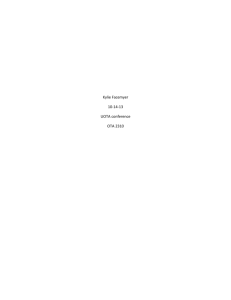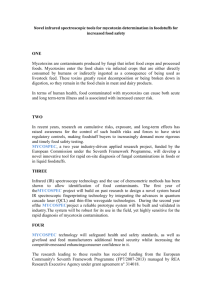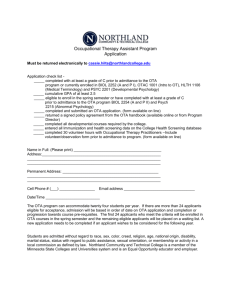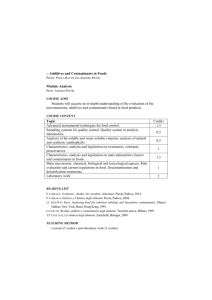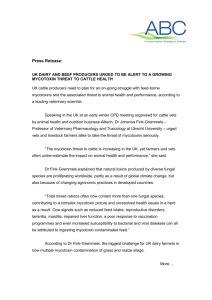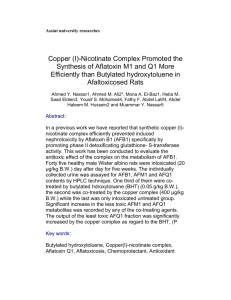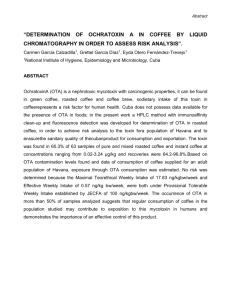Review on mycotoxin risk
advertisement
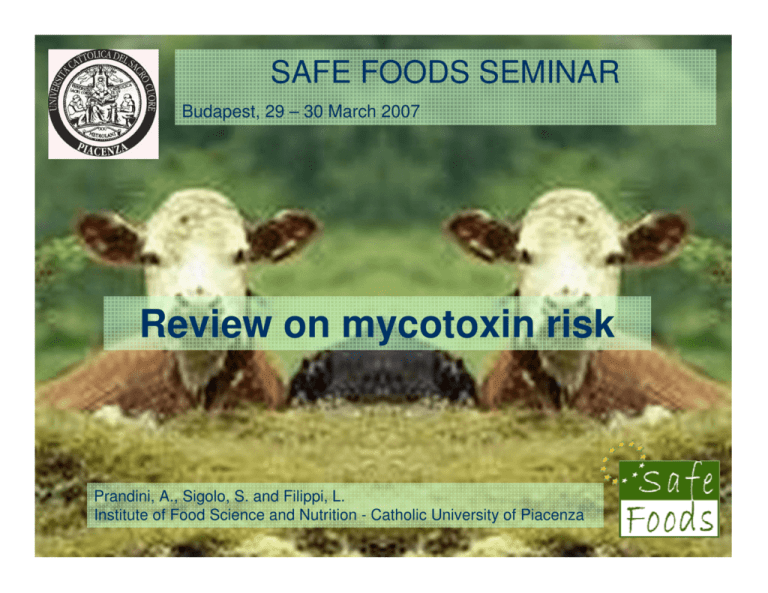
SAFE FOODS SEMINAR Budapest, 29 – 30 March 2007 Review on mycotoxin risk Prandini, A., Sigolo, S. and Filippi, L. Institute of Food Science and Nutrition - Catholic University of Piacenza ‘MYCOTOXIN’ Secondary toxic chemical substances produced by fungi Potential threat to human and animal health (inhalation, absorption, ingestion of contaminated food products) One or more fungal species one or more mycotoxin Major mycotoxins Aflatoxins Aspergilli – Penicillium verrucosum Ochratoxins Aspergillus ochraceus – P. verrucosum Deoxynivalenol F. graminearum – F. culmorum Fumonisins Fusarium spp. MYCOTOXIN EFFECTS Manifest effects with doses close to acute toxicity Belated symptoms Long-term effects after suspension Symptoms frequently confused by multi-presence and conventional induced pathologies SUSPECTED SYMPTOMS − reduced ingestion − reproductive problems − nephropathy − breathing sindrome − worsening of performance Other effects Economic losses FAO values in many milions of $ per year the losses due to MYCOTOXIN contaminations About 25% of world cereals harvest is contaminated of MYCOTOXIN Losses had been shown in the intere food chain, from production of cereals and feedstuffs to their processing and distribution, including losses in animal-breedings Excluding sanitary costs for human health Mycotoxins were associated to food problems in: France (16th) England (17th), Central-Eastern Europe Ethiopia and India (last 30 y), Africa, Asia Italy (1970’s) Denmark (mid-1980s) Malaysia and the Netherlands (1990’s) Eastern Kenia (2004) …. The secondary toxic metabolites are formed in the final exponential growth phase of fungi AFM1 DON FM B1 OTA MYCOTOXIN CONTAMINATION In field stresses predispose plants to infestation and colonization by toxigenic fungi (substrate with low moisture: 20-21%) In stored grain the contamination is influenced by: moisture (0.7 aw) temperature (10°- 40°C) substrate oxygen (O2; 1-2%) and carbon dioxide (CO2) concentration pH (4-8) Quality loss and mycotoxin formation is of particular concern when toxins enter human food chain by direct consumption MYCOTOXINS Stable substances after the fungal death PREVENTIONOF OFCONTAMINATION CONTAMINATION PREVENTION == PREVENTFUNGAL FUNGALGROWTH GROWTH PREVENT => => CONTROLTHE THEEFFECTS EFFECTS CONTROL MYCOTOXINS T2 – HT2 - OCHRATOXINS °C 5 - 15 DON – ZEA 15 – 30 FUMONISINS 25 – 35 AFLATOXINS 15 - 35 T2 TOXINS - HT2 - OCHRATOXINS DEOXYNIVALENOL ZEARALENONE OTA FUMONISINS - AFLATOXINS AFLATOXINS MYCOTOXIN RISK Limited effect of acute mycotoxin exposure Pre-harvest control of fungi growth by insufficient or excessive rainfall during crop development Changes in global climatic conditions FOOD QUALITY AND FEEDING NECESSITY New EU Membres States increase demand for food Adequate growth of agricultural industry in particular contexts Implementation of trading system inside an enlarged panEuropean market and ….. Improvement of analytical methods to detect toxins in foods and feeds It is necessary to fulfill the requirements of CEN (European Committee for Standardization) LEGISLATION EU REGULATION n. 1881/2006 set maximum limits for contaminants: in particular, Article 3 Prohibitions on use, mixing and detoxification 4. Foodstuffs containing contaminants listed in section 2 of the Annex (Mycotoxins) shall not be deliberately detoxified by chemical treatments EU RECCOMENDATION n. 2006/576/EC on the prevention and reduction of Fusarium toxins in cereals and cereal products RASFF 2005 2006 Mycotoxins: 989 892 Aflatoxin 939 812 Iran 452 (440*) 240 (233*) *pistachios China 80 (79**) 69 (66**) **peanuts & deriv. Brazil 37 (32**) 26 (20**) (country of origin) origin) Argentina 23 (22**) Ochratoxin A 16 12 10 3 Patulin 6 Fumonisin 2 Zearalenone 0 45 (42**) 26 dried vine fruits 4 spices 13 coffee & its products 11 cereals & their products 7 apple & derived 17 cereals 1 cereals ITALY 2005 2006 Mycotoxins: 13 Aflatoxin 10 14 4 maize flour & pistachio Ochratoxin A 2 1 Patulin 1 0 Fumonisin 1 9 maize flour Zearalenone 0 0 and Deoxynivalenol? Deoxynivalenol Though it is an emerging health risk, RASFF not noted by among the most serious present contaminations BALKANS AND CAUCASUS REGIONS Hungary OTA (coffee) from importation ZEA (wheat) 0.5% > allow. limits DON (feeding cereals) 88% > allow. limits Poland AFs (peanuts, pistachios) from importation OTA (rye, wheat, barley) 50 % > allow. limits DON (wheat, maize) 50 - 100% > limits ZEA (wheat, maize) 100 % < allow. limits OTA (wheat) 7.1% > allow. limits Russia DON (wheat, barley) 70 – 100 % > limits ZEA (wheat) 68 % < allow. limits OTA (barley) high level of contam. Romania MYCOTOXIN - CONCLUSION Awareness will be a contributing factor to reduce occurrence of mycotoxin in the years to come (National authorities should educate producers) Good Agricultural Practices (GAP) GAP represent the primary line of defense against contamination of cereals with mycotoxins More knowledge of the storage conditions under which mycotoxin production and inhibition takes place may make it possible to control further increases in mycotoxin levels during storage (GMP) … more information European Mycotoxins Awareness Network (EMAN) http://www.mycotoxins.org Scientific Committee for Food (SCF) http://europa.eu.int/comm/food/fs/sc/scf/reports/ Codex Alimentarius Commission www.codexalimentarius.net/download/report/28/Al03_12e.pdf European Food Safety Authority (EFSA) http://www.efsa.eu.int/science/contam/contam_opinions Scientific Cooperation (SCOOP) http://europa.eu.int/comm/food/fs/scoop/ European Commission Regulation (CE) n. 1881/2006 http://europa.eu.int/eur-lex/lex/JOIndex.do? year 2006 OJ series L OJ number (mandatory) 364 A case study on the occurrence of Aflatoxin M1 in milk and dairy products Prandini, A., Sigolo, S. and Filippi, L. Institute of Food Science and Nutrition - Catholic University of Piacenza AFLATOXINS Aspergillus flavus Aspergillus parasiticus A. nomius, Penicillium verrucosum FUNGUS SPECIES MYCOTOXINS TEMPERATURE RANGE (°C) Aspergillus flavus AFB1 AFB2 6 - 48 Aspergillus parasiticus AFB1 AFB2 AFG1 AFG2 WATER ACTIVITY (aw) optimum 36 - 38 Contaminated commodities: cereals, tree nuts, spices, oilseeds and in particular maize, peanut and cottonseed Major hazard: most widely occurrence (CAST, 1989) and our inability to detect them biologically >0.78 CONTAMINATION Direct: Fungal growth for fermentation (cheese, Penicillium) Unintentional fungal growth (uncorrect manifacturing) Indirect: Contaminated rations for cows (AFM1 in milk) AF: liver damage and cirrhosis, cytotoxic, mutagenic, tumor inducing and carcinogenic potency, immunosuppressive AFB1: class 1 (human carcinogenic IARC, 1993) AFM1: class 2B (possible human carcinogenic IARC, 1993) • Continued exposure to sub-acute levels bring chronic effects Milking animals that ingest aflatoxin B1 (AFB1) by contaminated diets, excrete the 4-hydroxylated metabolite aflatoxin M1 (AFM1) into milk with a proportion of 1-3% LEGISLATION The Commission set limit for AFB1 of 5 g/kg for supplementary feedstuffs for lactating dairy cattle (European Commission, 1991) tolerance level is difficult to be observed to produce bulk milk <50 ng AFM1 per kg = the daily average individual intake in a herd is <40 g AFB1 per cow The EU Commission fixed a limit for AFM1 of 50 ng/kg for milk and a variable limit for cheese In particular to protect children, milk has greatest potential for introducing AF in human diet: AFB1 transfer in breast milk Aflatoxins in milk are stable during heating treatments i.e. pasteurization and sterilization EU limit: 50 ng/kg of AFM1 Variation of pH during fermentation (yoghurts, cheeses) cause coagulation of proteins that adsorb or occlude the toxins EU limit: variable RISK FACTORS ANALYSIS AFB1 analysis in corn is necessary to evaluate risk of AFM1 contamination in milk and dairy products If stresses affect plant growth during pollination Aspergillus fungi increase AF level Risk factors of AFB1 contamination in corn Preventive measures: reduce fungal growth and aflatoxin B1 formation in agricultural commodities intended for animal feeds Controlling aflatoxin M1 in the food supply: reduce contamination with aflatoxin B1 of raw materials and supplementary feedstuffs for dairy cattle Risk factors of AFB1 contamination in corn silage production PRE-HARVEST HARVEST SILAGE AND STORAGE Choice of seeding time and density Low silage moisture Unsuitable filling and closing of storage silo Lack of irrigation and weed killing Long and irregular cutting up No use of organic acids and/or preservatives Phytophagous damages Excessive or not balanced fertilization Risk factors of AFB1 contamination in corn grain production PRE-HARVEST HARVEST POST-HARVEST PREPROCESSING Such as corn silage production and Mechanical damages Drought and high temperature (>2530°C) Prolonged drying in field Wet grain storage before drying process Minimum tillage or sod seeding Choice of hybrids Unsuitable crop rotation Grains storage with moisture > 14% Unsuitable driers No kernels cleaning No refrigeration No phytophagous control Grain heating Grains rehumidification Aspergillus spp. are competitive with Fusarium and other toxigenic fungi under 0.78 aw Climatic conditions are closely interrelated with AFB1 incidence and contamination levels; particular climatic conditions for the first time in Italy during summer 2003 conduced to a significant diffusion of aflatoxins: Year AFB1(>0.2 ppb) Year AFB1 (>0.2 ppb) 1995 1.9 2000 0.0 1996 0.3 2001 6.3 1997 1.5 2002 2.1 1998 1.5 2003 14.3 1999 4.1 2004 3.3 % contaminated corn samples superior to the instrumental limit in Pianura Padana (Po Valley) (Pietri et al, 2004; Reyneri, 2006) PREVENTION OF RISK IN MILK With high temperature and high humidity in field it is difficult to prevent the formation of aflatoxins SCOUTING: SCOUTING land control of ‘stressed’ culture Essential to be careful in post-harvest storage (1212.5 % RH) Suppliers careful of mycotoxin risk, in particular of aflatoxin risk (HACCP) Choice alternative feedstuffs without hazardous raw materials WHAT COULD WE DO WITH CONTAMINATED MATERIAL ? (elusive goal) Detoxification of FEEDSTUFFS • ammonia (gaseous phase): alteration of molecular structure • sodium bentonite and aluminosilicates: binding agents • sodium-, potassium-, calcium-hydroxide (with formaldehyde) • ADSORBENTS MILK • acidification of milk with organic acid (lactic, citric or acetic) • addition of formaldehyde (0.5%) • via Nocardiaceae (Flavobacterium aurantiacum = Nocardia corynebacterioides) New utilization • corn production of ethanol or wet milling • milk meal for swine Distruction (following national impositions, Italy – 2003) WORST CASE SITUATION for ruminants (cattle, buffalos, sheep, goats) Occurrence of AFB1 at maximum permissible level in feed concentrates Maximum concentrate intake of high yielding dairy cow Contamination of basic feedstuffs in rations of dairy cows at maximum permissible level Climate change in Southern Europe AFM1 - CONCLUSION Attention on the most sensitive steps of feedstuffs production Controlling critical point for fungal growth and mycotoxins production such as cultural phases Primary strategy to protect: monitoring by reliable analyses surveillance could be appropriate Spreading news about risks linked to unsuitable farming management systems On the occurrence of Deoxynivalenol and Ochratoxin A in wheat Prandini, A., Sigolo, S. and Filippi, L. Institute of Food Science and Nutrition - Catholic University of Piacenza DEOXYNIVALENOL (DON) Fusarium graminearum (maize) Fusarium culmorum (wheat) FUNGUS SPECIES TEMPERATURE RANGE (°C) WATER ACTIVITY (aw) Fusarium graminearum 25 - 30 >0.88 Fusarium culmorum 21 - 25 >0.87 >0.88 Contaminated commodities: barley, wheat, oats, rye, triticale, maize, buckwheat, sorghum, and rice Major hazard: occurrence at undetectable level in a wide variety of food CONTAMINATION The exposure varies with supplies in different geographical regions: regions in Europe major source is wheat in Asia major sources are rice and wheat DON: acutely cytotoxic and strongly immunosuppressive, neural disturbance, haemorrhaging, necrosis of tissue, vomiting and feed refusal (= vomitoxin) DON: a class 3 (not classifiable as to its carcinogenicity to humans IARC, 1993) EU REGULATION n. 1881/2006 LEGISLATION The Commission set limit of DON g/kg : 500 (bread) - 1750 (not manifacturated wheat and corn) Canada , Russia guideline limits : 500 – 2000 g/kg (wheat) and the USA set statutory or RISK FACTORS ANALYSIS DON analysis in wheat is necessary to evaluate risk of DON contamination in by- products Direct relationship between incidence of FHB and DON contamination of wheat Infection depend on: Rainfall and relative humidity (RH) Duration of canopy wetness Temperature related to the stage of wheat development To prevent in field, condition for DON contamination Risk factors of DON contamination in wheat and bread WEATHER High temperature High moisture Rainfall (among flowering and early dough stage) AGRICULTURAL PRACTICES Unsuitable crop rotation No removal of crop debris Excessive N fertilization Choice of variety No chemical or biological control POSTHARVEST Unsuitable conditions of conservation (SMC) Damaged kernels No chemical or alternative control Unsuitable conditions of transport MILLING AND BREAD PROCESSING Wholemeal bread production PREVENTION OF RISK IN FIELD Good agricultural, handling, and storage practices are required in conventional, as well as in organic, agriculture to minimize the risk of mould growth and mycotoxin contamination, for instance: Long crop rotations (crop/species-specific mould) Low/different nitrogen fertilization rates (rough plants) Tilling as weed control (minor fungal inoculum) Lack penetration of grain by Fusarium spp is conducive for a high DON production for competition during storage DON - CONCLUSION Scouting crop during most sensitive period (among flowering and early dough stage) to reduce the risk of FHB outbreaks Controlling critical points for fungal growth and mycotoxin production such as cultural techniques Under good condition of storage, Fusarium species do not compete with other storage-fungi Seeds mantain good quality at 25°C and with 62% RH during storage OCHRATOXIN A (OTA) Penicillium verrucosum (temperate climate) Aspergillus ochraceus, A. carbonarius (warm climate) FUNGUS SPECIES Penicillium verrucosum Aspergillus ochraceus TEMPERATURE RANGE (°C) WATER ACTIVITY (aw) 0 - 31 < 0.80 Optimum 20 12 - 37 > 0.80 Optimum 24-31 Optimum 0.95 – 0.99 Contaminated commodities: rice, barley, maize, rye, wheat grapes, legumes, coffee, dried and stored foods Major hazard: occurrence at low level in a wide variety of food CONTAMINATION Direct: Ingestion of contaminated cereals, cereals juices Inhalation in people working on waste fields (rarely) Indirect: - Contamined feed for monogastric animals (OTA in meat, liver paté) OTA: immunosuppressive, embriotoxic, carcinogenic and teratogenic, genotoxic, nephrotoxic in mammalian species (BEN = Balkan Endemic Nephropaty, 1991) OTA: class 2B (possible human carcinogenic IARC, 1993) Carry-over: - limited in ruminant probably due to detoxification activities of microflora - depend on tissue in meat production (swine, poultry) OTA has the longest half-life (35 days) known for living mammals: accumulation bring to chronic effect LEGISLATION The Commission set limit for OTA of 2 - 10 g/kg from not manifacturated wheat and corn to soluble coffee EU limit: 5 g/kg of OTA (wheat and corn) EU limit: 5 g/kg of OTA (roasted coffee) According to the occurrence in many food it was established a provisional Tolerable Daily Intake (TDI) of: 14 ng OTA /kg b.w./day (JECFA) 5 ng OTA /kg b.w./day (EU SCF) Ochratoxin A is stable to heat (bread-making), to roast (coffee), to fermentation (wine, beer): EU limit: 2 g/kg of OTA (wheat and corn byproducts) EU limit: 0.5 g/kg of OTA (baby food, infant formula with cereals) RISK FACTORS ANALYSIS OTA analysis in wheat is necessary to evaluate risk of OTA contamination in bread OTA occurrence is related to climate and especially A. ochraceus and P. verrucosum occur in stored grains: main control of fungal growth in post-harvest conditions Infection depend on: Moisture of grains at harvest: 0.77 aw Temperature Controlled atmosphere during storage A good storage practice to prevent OTA production Risk factors of OTA contamination in bread POST-HARVEST Unsuitable conditions of conservation: Insufficient drying Over-long storage before drying No chemical or alternative control Damaged kernels WHEAT MEAL PRODUCTION No cleaning of kernels No scouring of kernels BREAD PROCESSING Wholemeal bread production WHAT COULD WE DO WITH CONTAMINATED MATERIAL ? Detoxification of SOLID MEDIA / AGRICULTURAL PRODUCTS • a strain of A. niger (normally use in fermentation of food) and A. fumigatus • ADSORBENT (stop carry-over in pig and chick) LIQUID MEDIA / MILK • Lactobacillus, Streptococcus and Bifidobacterium detoxify milk • A. Nigri and A. fumigatus Such methods must be : compatible with existing national and european food safety legislation (Reg. CE 1881/2006) protective of the functionality/quality of cereals OTA - CONCLUSION Exposure to OTA is worldwide (detected in human sera in many countries) with high incidence, at low level Difficulty of eliminating OTA from food chain makes it essential avoidance in raw materials, and protection from further contamination occurs Adoption of DO (designation of origin) system could reduce the OTA contamination (i.e. wine and PDO sausages in Italy) Controlling critical points for fungal growth and mycotoxin production such as storing techniques Prediction of mycotoxins using models Prandini1, A., Sigolo1, S., Filippi1, L. and Battilani2, P. 1Institute of Food Science and Nutrition 2Institute of Entomology and Plant Pathology Catholic University of Piacenza Forecasting AFB1 and AFM1 contamination Linear relationships between intake of aflatoxin B1 in feed and the aflatoxin M1 content of milk (carry-over) AFM1 (ng/kg milk) = [1.19 x AFB1 intake ( g cow-1 day-1)] + 1.9 AFM1 (ng/kg milk) = 10.95 + 0.787x AFB1 intake ( g day-1) (Veldman) (Pettersson) No predictive models for the risk of AFB1 contamination in corn or AFM1 contamination in milk and dairy products Prevention in field 1. Control insects and weeds 2. Scouting (EC Recc. 2006/576) 3. Minimize damage kernels Forecasting FHB epidemics FHB is an IDEAL disease, given : prevalence of FHB epidemics in wet growing season short period of anthesis when cereal ears are most susceptible to infection A generalized forecasting system is difficult to apply in a field situation Measures of control as: use of cultural control techniques growing of resistant cultivars use of fungicides or biological antagonist to reduce the risk of FHB epidemic Forecasting OTA contamination OTA production in grains is a IDEAL phenomenon, given: occurrence of A. ochraceus and P. verrucosum primarily in stored grains In a predictive model based on: temperature X aw different species Measures of control as: Cleaning and removal of damaged kernels Use of chemical control (fumigants) ARGENTINA (2001) Empirical equation for predicting FHB incidence: Temperature Moisture variable associated to head blight in many wheat cultivars The equations should be carefully used for prediction in other geographic areas, with few changes in temperature thresholds. ITALY (2002) FHB dynamic simulation model: daily infection risk based on Sporulation Spore dispersal Infection of host tissue Main factors affecting the risk for DON and ZEA Air temperature Relative humidity and rainfall Fungal species and host growth stage Model produce one index for FHB risk, and one for mycotoxin level in grain CANADA (2002) DON prediction in mature grain using: Rainfall Temperature (4 -7 days before heading and from 7 days before to 10 days after heading) Predictive model for timing use of fungicides A web site (http://www.ownweb.ca) provide predictions of DON across the province of Ontario in Canada (Hooker et al., 2002; Hooker et al., 2003). USA (2004) Model for FHB disease based on: Weather (hourly temperature, humidity and rainfall) Crop growth stage Disease observations Predict the risk of disease severity greater than 10% The model accuracy was near 80% based on data use for the validation of the system With integration of empirical observation the model is given for prediction of DON level in grain A web site (www.wheatscab.psu.edu) provide data from 23 states both spring and winter wheat areas EUROPE (2003) Predictive model about ochratoxin A production in stored grain (OTA PREV project) Fungal growth and OTA production are influenced by: abiotic (mainly water availability and temperature) and biotic factors. Mathematical model use: numbers of P. verrucosum colonies moisture content during storage They are significantly related to the risk of exceeding the ‘5 µg OTA kg-1 grain’ legislative limit Predictive models on Fusarium verticillioides and fumonisin contamination in maize Variables used: air temperature relative humidity wetness free water in plant tissue corn growth stage and mathematical equations related to spore production, infection, invasion and mycotoxin production. Italy: conceptual model for the dynamic simulation of the life cycle of F. verticillioides in maize and production of fumonisin B1 in grain in dry and warm climates of southern Europe. To produce an operative model, some aspects of the disease cycle need to be investigated further ‘PREDICTIVE’ - CONCLUSION Implementation of food safety measures (GAPs, GMPs, HACCP system) to reduction of mycotoxins in first steps of commodities production The employment of meteorological predictive models may be useful for decision-making purposes for the use of fungicides allowing to prevent losses of yield and hazards for human and animal health OVERALL CONCLUSIONS Mycotoxins can be produced in field as well as during food storage, and a variety of climatic, environmental and agronomic factors determine their production Prevention of growth and mycotoxin production of fungi on plants and in feedstuffs is the best approach to impede the harmful effects on animal and human health Contribute to frequency and worldwide diffusion of mycotoxin contamination is the global transportation and food conservation systems and also It’s difficult to forecast the occurrence of fungal diseases and toxins contamination in food grains Predictive models are limited to climatic variables (no use of field specific effects such as crop rotation, crop variety, tillage, etc) They are usually site-specific and do not provide acceptable accuracy when applied to diverse and complex environments (also human behaviour influence mycotoxin problem but is difficult to quantify) IN THE FUTURE? Researches about genetic resources for improvement of resistance or less susceptibility of plants to contamination Integration of predictive models with GAPs and GMPs to prevent contamination risk Disclosure of guidelines (‘know how’) to harmonize the storage centres about the best way for managing and storing commodities National storage centres have due to follow guidelines for good conservation of commodities Bigger pertaining areas are conducive to better management Thanks for your attention
